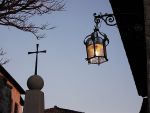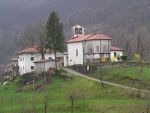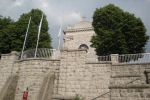

The linking path of the three Mary’s temples
 The linking path of the three Mary temples is a thematic path that connects three Mary’s temples: Sveta Gora (Saint Mount) in the Municipality of Nova Gorica and Marijino Celje (Maria Zell) in the Municipality of Kanal ob Soči – both of them are situated on the Slovenian side, and Stara Gora (Castelmonte) on the Italian side. All these three temples are a well-known and popular place of pilgrimage.
The linking path of the three Mary temples is a thematic path that connects three Mary’s temples: Sveta Gora (Saint Mount) in the Municipality of Nova Gorica and Marijino Celje (Maria Zell) in the Municipality of Kanal ob Soči – both of them are situated on the Slovenian side, and Stara Gora (Castelmonte) on the Italian side. All these three temples are a well-known and popular place of pilgrimage.
It takes two days to pass through the last two paths, but the pleasure that they offer is certainly greater.
Footpath between the temples
 From Sveta Gora (at 682 m above sea level) go down up to the Preški vrh Peak, and proceed in the direction of the hamlet of Baske towards Kanal. This is a 12.1 km-long road, which can be passed through in 5 hours. In Kanal, go across the bridge and proceed on a winding steep road towards Lig up to Marijino Celje ((at 620 ms.l), and continue, proceeding on above-mentioned road towards Stara Gora. If you opt for the footpath, it will take you an hour and a half from Lig to Britof (3.5km), from where you ascend past the hamlet of Kodermaci up to Oborče, and then towards Sv. Anton and the villages of Markolini and Kauc up to Stara Gora. It will take you approximately an hour to reach Oborče, and another half an hour to reach Markolini, and an additional hour and a half to reach Stara Gora.
From Sveta Gora (at 682 m above sea level) go down up to the Preški vrh Peak, and proceed in the direction of the hamlet of Baske towards Kanal. This is a 12.1 km-long road, which can be passed through in 5 hours. In Kanal, go across the bridge and proceed on a winding steep road towards Lig up to Marijino Celje ((at 620 ms.l), and continue, proceeding on above-mentioned road towards Stara Gora. If you opt for the footpath, it will take you an hour and a half from Lig to Britof (3.5km), from where you ascend past the hamlet of Kodermaci up to Oborče, and then towards Sv. Anton and the villages of Markolini and Kauc up to Stara Gora. It will take you approximately an hour to reach Oborče, and another half an hour to reach Markolini, and an additional hour and a half to reach Stara Gora.
 On the way of the three temples, apart from the marvellous temples themselves, visitors can also admire natural, historical and cultural attractions of these places. In Kanal, you can visit the old town centre with Riko Debenjak’s gallery, a Gothic house, the picturesque Kontrada Square with the remains of defence towers, the Marija Vnebovzeta Church and the Neptune Fountain. If you opt for visiting Kanal during the summer, you can also come across some of numerous events that take place outdoors: music or cultural festivals, sporting events, such as World Cup Diving or even traditional diving from the bridge. Apart from the unspoilt countryside of Kanalski Kolovrat, you can also visit one of the private collection of things from World War I, old houses (such as the Lukčeva hiša House in Kambreško, where you can see a well-preserved old fireplace). Beekeepers will offer you excellent honey, which was produced in the forests in unspoilt countryside of Kanalski Kolovrat. In autumn, you can go to the traditional chestnut festival that is held in the village of Lig. In case you opt for visiting Kanalski Kolovrat during the first months of the year, you will come across lively dressed up people of Lig.
On the way of the three temples, apart from the marvellous temples themselves, visitors can also admire natural, historical and cultural attractions of these places. In Kanal, you can visit the old town centre with Riko Debenjak’s gallery, a Gothic house, the picturesque Kontrada Square with the remains of defence towers, the Marija Vnebovzeta Church and the Neptune Fountain. If you opt for visiting Kanal during the summer, you can also come across some of numerous events that take place outdoors: music or cultural festivals, sporting events, such as World Cup Diving or even traditional diving from the bridge. Apart from the unspoilt countryside of Kanalski Kolovrat, you can also visit one of the private collection of things from World War I, old houses (such as the Lukčeva hiša House in Kambreško, where you can see a well-preserved old fireplace). Beekeepers will offer you excellent honey, which was produced in the forests in unspoilt countryside of Kanalski Kolovrat. In autumn, you can go to the traditional chestnut festival that is held in the village of Lig. In case you opt for visiting Kanalski Kolovrat during the first months of the year, you will come across lively dressed up people of Lig.
The Marijino Celje Temple
 In the past, the temple was mentioned for the first time in 1325 with the name “De S. Zenone de supra Judrium,” and afterwards, in 1344 it was named “Sancti Zenonis in Sclauonibus. Judging from its characteristics, i.e. from arched presbytery and a bell with a date 1575, it is regarded as the second Saint Zenon Church in late Gothic style, which was built in the 16th century. Up until 1757, when it became vicariate church, the Saint Zenon Church was a subsidiary church of the old parish church in Kanal. After 1761, when the symbol of the merciful saint, i.e. a copy of the statue from the biggest Central European Mary Temple in the Austrian Styria, was transferred, the Maria Zell Church became a pilgrimage church. In the second half of the 18th century, the church was renovated. It was built a characteristic dominating landscape feature with two bell towers ornamented with tin endings, such as those you can find in Goriška Brda and in the Natisone Valley. In 1825, the right bell tower was demolished, and in 1997, both bell towers were again renovated. The altar of this day was built in 1847, while the main altar is thought to be constructed during Pacassi’s workshop, i.e. in 1686. After having been used for 100 years in Sveta Gora, in the time of Joseph II in 1786, it was transferred to the Marijino Celje Church. During the periods between 1786 and 1793, and between 1915 and 1928, in the time of its devastation, Marijino Celje took over the pilgrimage role of Sveta Gora.
In the past, the temple was mentioned for the first time in 1325 with the name “De S. Zenone de supra Judrium,” and afterwards, in 1344 it was named “Sancti Zenonis in Sclauonibus. Judging from its characteristics, i.e. from arched presbytery and a bell with a date 1575, it is regarded as the second Saint Zenon Church in late Gothic style, which was built in the 16th century. Up until 1757, when it became vicariate church, the Saint Zenon Church was a subsidiary church of the old parish church in Kanal. After 1761, when the symbol of the merciful saint, i.e. a copy of the statue from the biggest Central European Mary Temple in the Austrian Styria, was transferred, the Maria Zell Church became a pilgrimage church. In the second half of the 18th century, the church was renovated. It was built a characteristic dominating landscape feature with two bell towers ornamented with tin endings, such as those you can find in Goriška Brda and in the Natisone Valley. In 1825, the right bell tower was demolished, and in 1997, both bell towers were again renovated. The altar of this day was built in 1847, while the main altar is thought to be constructed during Pacassi’s workshop, i.e. in 1686. After having been used for 100 years in Sveta Gora, in the time of Joseph II in 1786, it was transferred to the Marijino Celje Church. During the periods between 1786 and 1793, and between 1915 and 1928, in the time of its devastation, Marijino Celje took over the pilgrimage role of Sveta Gora.
Frescoes of Saint Florian, Saint Anthony the Abbot, Saint Anthony Padovano, Saint Valentin and Stations of the Cross, dating back to 1849, were produced by the painter Antonio Dugoni from Cividale. Anna’s image in the left lateral altar was produced by Raffael Pich from Gorica in 1837. The aisle ceiling, painted in 1926 and 1927, and Saint-Zenon’s painting were produced by Leopold Perc from Lucinico. Four evangelists on the aisle ceiling and the Ascension on the right lateral altar is thought to be painted by Clemente de Neri.
Saint Kancijan Church in Britof
 On the way of the three temples, you can admire a number of churches; one of them is the parish church of St. Kancijan in Britof at 260m above sea level, it is situated in the immediate vicinity of the frontier with Italy. The St. Kancijan Church, which was built in the Gothic style, has a short and wide aisle, and a relatively deep presbytery made out of cut stone. It has a high wall, and in the middle, at the window level, there is a wall in a form of a roof. Above it, in the north-east part of the corner, there is an engraved date 1504. The church has a sharp front gate with some Gothic characteristics and it has an engraved date 1505. In its lovely interior, visitors can admire many artistic details, which reveals its Gothic characteristics and changing through the time. Looking from the outside, there is a sharp triumphal arch, and Gothic mural paintings that have been preserved. In its upper part, you can see a separated scene of Cain’s and Abel’s sacrifice. Close to it, on both the sides, there is one figure from the Annunciation, which is characteristic for triumphal arches. On the right side, you can admire the image of St. Simon, while in the south part there is the Crucifixion. All these paintings embellish the vicinity of the lateral altar.
On the way of the three temples, you can admire a number of churches; one of them is the parish church of St. Kancijan in Britof at 260m above sea level, it is situated in the immediate vicinity of the frontier with Italy. The St. Kancijan Church, which was built in the Gothic style, has a short and wide aisle, and a relatively deep presbytery made out of cut stone. It has a high wall, and in the middle, at the window level, there is a wall in a form of a roof. Above it, in the north-east part of the corner, there is an engraved date 1504. The church has a sharp front gate with some Gothic characteristics and it has an engraved date 1505. In its lovely interior, visitors can admire many artistic details, which reveals its Gothic characteristics and changing through the time. Looking from the outside, there is a sharp triumphal arch, and Gothic mural paintings that have been preserved. In its upper part, you can see a separated scene of Cain’s and Abel’s sacrifice. Close to it, on both the sides, there is one figure from the Annunciation, which is characteristic for triumphal arches. On the right side, you can admire the image of St. Simon, while in the south part there is the Crucifixion. All these paintings embellish the vicinity of the lateral altar.
 The church is undoubtedly food for eyes for all the lovers of this type of cultural heritage. The big golden altar is certainly the most interesting feature in the church. The altar is a typical ‘representative’ of the so-called golden altar from the 17th century. It is made of lime wood elaborated with gypsum, colouring and gilding. The altar is proportionally wide and it has three floors. Its small columns are decorated with the characteristic themes of that time: with angels and saints. In the main part there are statues of three martyrs: Kancijan, Kancij and Prot; while close to the church wings, there are the apostles Simon Gorečnik and St. Juda Tadej. In the first floor, the Baptism in Jordania is represented, while , there is St. Antonio Padovani on the left, and St. Florian on the right . Above it, Holy Trinity’s giving the crown to Maria is represented. The altar is a real richness of images and themes of the renaissance, which goes perfectly with the Gothic features of the church.
The church is undoubtedly food for eyes for all the lovers of this type of cultural heritage. The big golden altar is certainly the most interesting feature in the church. The altar is a typical ‘representative’ of the so-called golden altar from the 17th century. It is made of lime wood elaborated with gypsum, colouring and gilding. The altar is proportionally wide and it has three floors. Its small columns are decorated with the characteristic themes of that time: with angels and saints. In the main part there are statues of three martyrs: Kancijan, Kancij and Prot; while close to the church wings, there are the apostles Simon Gorečnik and St. Juda Tadej. In the first floor, the Baptism in Jordania is represented, while , there is St. Antonio Padovani on the left, and St. Florian on the right . Above it, Holy Trinity’s giving the crown to Maria is represented. The altar is a real richness of images and themes of the renaissance, which goes perfectly with the Gothic features of the church.
 Another interesting feature is also the Gothic church wing altar, which has been preserved from the old church furniture and in the past times, it stood in the place of the golden altar. Today it is situated on the right side, close to the triumphal arch’s wall under the frescoes. The altar is composed of a wardrobe with two wings. When the wardrobe wings are closed, the altar represents the image of Mary’s Annunciation. On Sundays and festivals, wardrobe’s wings used to be open and represented the apostles St. Simon’s and Juda Tadej’s image. In the wardrobe itself, there three important men are represented. According to subtitles, these men are thought to be St. Barnaba, St. Kancijan and St. Gerijan. This altar is one of the rarest of this type which has been preserved in Slovenia, and it dates back to 1520.
Another interesting feature is also the Gothic church wing altar, which has been preserved from the old church furniture and in the past times, it stood in the place of the golden altar. Today it is situated on the right side, close to the triumphal arch’s wall under the frescoes. The altar is composed of a wardrobe with two wings. When the wardrobe wings are closed, the altar represents the image of Mary’s Annunciation. On Sundays and festivals, wardrobe’s wings used to be open and represented the apostles St. Simon’s and Juda Tadej’s image. In the wardrobe itself, there three important men are represented. According to subtitles, these men are thought to be St. Barnaba, St. Kancijan and St. Gerijan. This altar is one of the rarest of this type which has been preserved in Slovenia, and it dates back to 1520.
The other two temples, consecrated to Mary, are Sveta Gora close to Nova Gorica, and Stara Gora (Castelmonte) close to Cividale in Italy.
© Apartma Valentinčič 2013